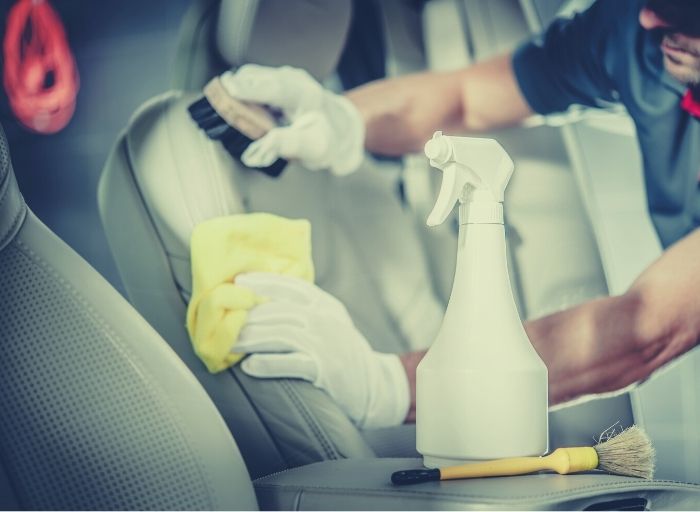
Although sunscreen is beneficial to your skin, it is not something you want to see on your car’s vinyl or leather upholstery. The sunscreen easily stains your car’s inside, especially dark hues, leaving unsightly streaks and splotches that can make your car’s interior look unkempt. Moreover, most creams are waterproof or water-resistant, which means they won’t wash off. So, how to remove sunscreen from car interior?
Table of Contents
How to Remove Sunscreen from Car Interior
The following are some common household items that can remove sunscreen stains from vehicle seats.
1. Rubbing alcohol or white vinegar
Because they are common household goods, rubbing alcohol and white vinegar are popular cleaning products that are effective at dissolving oil-based contaminants and are inexpensive techniques for cleaning your car’s inside.
To use these agents to remove sunscreen stains, spray or pour a moderate amount of the agents directly over the stain. The next stage is determined by the material used in your interior.
Interior made of leather
If you have leather seats, wipe the vinegar or alcohol on them with a non-abrasive sponge and then wipe it away with a microfiber towel. As leather is a natural product, strong chemicals or substances such as vinegar and alcohol can cause it to dry up and become damaged if left on it for too long.
Although most leather automobile interiors have a protective layer to ensure their longevity, you should keep the vinegar and alcohol away from them for as long as possible. Once you’re sure the sunscreen is gone, shower the area with warm water and let it dry thoroughly to ensure no residues of vinegar or alcohol remain.
Interior made of non-leather
Leave the vinegar or alcohol to absorb into the fabric for around 3-5 minutes if your car inside is made of a different material, such as polyester, for the greatest results. You’ll follow the same methods as before (spray and scrub). Rather than wiping away the cleaning agents immediately, you’ll allow them a little more time to break up the sunscreen’s oils.
Note: Some people feel that a scrub brush is more efficient than a scrub pad for polyester.
2. Soapy water
If you’ve ever tried to remove a stain from another surface, you’ve certainly noticed that soapy water is a tried and effective method for removing the stain and returning the area to its former state. Yet, you should really make sure that you follow the guidelines below to avoid causing any damage or utilizing something that you shouldn’t.
This procedure is adaptable and may be used on almost every interior surface in your vehicle, regardless of the material. With this procedure, you may discover that some stains are too stubborn to remove, which is great; you may switch to another if necessary. Nonetheless, any standard old or new stain should work with this one.
Clean away any residue with a gently damp wipe or tissue if the stain is fresh or has a tacky surface. If wiping doesn’t work, try blotting instead. This stage will make the subsequent ones easier and less messy.
After you’ve wiped away the stain, you may begin preparing the stain-lifting mixture. Simply combine lukewarm water with any mild soap that will not damage your inside.
Scrub the stain gently with the mixture you’ve made using a sponge or washcloth, then repeat until the stain has gone to show the outcome. Wipe dry with a clean washcloth. If the stain persists after your initial attempt, you may try this procedure again or move on to another on this list!
3. Corn starch or baking soda
Another popular household ingredient that is regularly used for cleaning is baking soda. This procedure is recommended for fresh stains on more difficult car interior aspects, such as the carpet.
If your sunscreen stain is fresh, try blotting up as much as possible with a rag or paper towel before pouring baking soda on the afflicted area. Corn starch is a good substitute for baking soda if you don’t have any.
Scrub the baking soda/cornstarch into the cloth with a brush, then let it sit for 15 minutes. These are absorbent materials that, ideally, will soak up any residual sunscreen while it sits, allowing for simple removal. Scrap or vacuum up the absorbing agent after 15 minutes to see if the sunscreen is still there. If the sunscreen is still visible, repeat the procedure.
So, what happens if the sunscreen isn’t brand new? Don’t panic. You can still remove it using baking soda or cornstarch. In these situations, we recommend combining the baking soda with white vinegar (with a 1:2 ratio, one part baking soda, two parts white vinegar) to get a thick, paste-like solution that you may scrub into the cloth. Allow it to stay for 3-5 minutes (or more if it’s a stubborn carpet stain) before cleaning it away to assess the stain.
4. Degreasers
Using a degreaser to remove sunscreen stains from the car’s interior is usually the best option. Many professional interior cleaning businesses use this product for quick, clean results. However, it is the more expensive technique because it isn’t something the average individual keeps on hand.
Regarding degreasers, one thing to remember is the terms of use. Many degreasers spray designed exclusively for car interiors can be used straight from the bottle, but some, particularly those purchased in jugs, maybe too strong on their own and require diluting before use. So, before you buy or start using your favorite degreaser, check the company’s terms of service to be sure it’s safe.
Again, you want enough cleaning agents to moisten the material. You don’t want to drench or oversaturate it, as this can cause damage and soak into underlying materials, such as seat cushions, which can take a long time to dry.
The techniques for removing sunscreen with a degreaser are the same as those with white vinegar or rubbing alcohol. Apply the cleaning agent, scrub it into the stain, let it set or remove it immediately, depending on the material, then wipe away the degreaser and see whether you must repeat the process.
Why Do You Want to Remove the Sunscreen from Your Car?

Many people are unaware that sunscreens are harmful to automobiles since they believe there is no danger in wearing one because its purpose is to protect us from UV rays when driving outside on hot days.
However, no amount of sunscreen will protect you from UV rays reflected off of cars and buildings, no matter how good it is.
Furthermore, because sunscreen is a petroleum-based substance that absorbs into these surfaces, it can harm dashboard surfaces and leather interiors.
Nobody likes a car with sunscreen spots on the dashboard or leather seats because they can’t appreciate the spotless dashboard or leather seats.
The sunscreen can cause damage to the exterior as well. Sunscreens can increase the likelihood of your car’s paint finish fading over time. This is because they coat the paint’s surface, preventing a protective layer from growing on top of it.
They have the potential to render surfaces white. This is related to mineral deposits that some products leave behind when used too freely.
Removing Sunscreen Stains from Leather Upholstery

To remove sunscreen stains from leather upholstery, you can follow these steps:
- Act quickly: The sooner you can address the stain, the easier it will be to remove it. Fresh stains are generally easier to treat.
- Blot excess sunscreen: Use a clean cloth or paper towel to blot any excess sunscreen from the leather surface gently. Be careful not to rub the stain, as it may spread further.
- Prepare a cleaning solution: Mix a small amount of mild liquid soap or dish detergent with warm water to create a soapy solution. Ensure the soap is gentle and contains no harsh chemicals or bleach.
- Test in an inconspicuous area: Before applying the cleaning solution to the stained area, test it on a small, inconspicuous spot of the leather upholstery. This step will help ensure that the solution doesn’t cause any discoloration or damage to the leather.
- Clean the stain: Dip a clean cloth into the soapy solution and wring out any excess liquid. Gently dab the cloth onto the sunscreen stain, working from the outside toward the center. Avoid scrubbing vigorously, as it may damage the leather.
- Blot the stain: After applying the soapy solution, use a fresh cloth or paper towel to blot the stain gently. This will help absorb the sunscreen residue and cleaning solution. Repeat this process with a clean cloth until the stain is no longer visible.
- Rinse the area: Dampen another cloth with clean water and gently wipe the area to remove any soap residue. Make sure to wring out the cloth well, as excessive water can damage the leather.
- Dry the leather: Use a dry cloth to absorb as much moisture as possible from the cleaned area. Allow the leather to air dry completely away from direct sunlight or heat sources.
- Condition the leather: Once the upholstery is dry, apply a leather conditioner specifically designed for your type of leather. Follow the product instructions to moisturize and protect the leather, which will help restore its natural luster and maintain its longevity.
If the stain persists or if you’re unsure about treating it yourself, it’s advisable to seek professional assistance from a leather cleaning specialist. They have the expertise and specialized products to tackle stubborn stains without damaging the leather upholstery.
Removing Sunscreen Stains from Fabric Upholstery
The procedure for removing sunscreen stains from fabric upholstery is slightly different from that of leather upholstery. Here’s how you can eliminate sunscreen stains from fabric upholstery:
- Blot excess sunscreen: Using a clean cloth or paper towel, gently blot the excess sunscreen from the fabric surface. Be careful not to rub the stain, as it may spread further.
- Check fabric care instructions: Before proceeding with any cleaning method, check the care label on the fabric upholstery for specific cleaning instructions. Different fabrics may require different approaches.
- Pretreat the stain: If the fabric is machine washable, pretreat the stain by applying a small amount of liquid laundry detergent directly to the stained area. Gently rub the detergent into the fabric using your fingers or a soft brush.
- Soak the fabric: Fill a sink or basin with cool water and submerge the fabric upholstery in the water. Allow it to soak for about 30 minutes. If the upholstery is not removable, use a clean cloth to dampen the stained area with cool water.
- Wash the fabric: If the fabric is machine washable, launder it according to the care label instructions using a mild detergent. If the fabric is not machine washable or if the stain remains after washing, proceed to the next step.
- Spot clean the stain: Create a cleaning solution by mixing a small amount of mild liquid laundry detergent with warm water. Dampen a clean cloth with the solution and gently blot the stain from the outside toward the center. Avoid rubbing the fabric vigorously, as it can damage the fibers.
- Rinse the fabric: Dampen another cloth with clean water and gently blot the treated area to remove any soapy residue. Repeat this step until the soap is fully removed.
- Air dry and assess the stain: Allow the fabric upholstery to air dry completely. Once dry, check if the stain has been completely removed. If it’s still visible, you may need to repeat the spot cleaning process or consider seeking professional upholstery cleaning services.
Remember, it’s essential to always test any cleaning solution on a small, inconspicuous area of the fabric upholstery before applying it to the stained area. This test will help ensure that the solution doesn’t cause any discoloration or damage to the fabric.
Dealing with Sunscreen Stains on Glass and Windows

Dealing with sunscreen stains on glass and windows follows a similar process. Here’s how you can remove sunscreen stains from glass and windows:
- Gather your supplies: You will need the following items: white vinegar, water, a spray bottle, a clean cloth or lint-free paper towels, and a non-abrasive sponge or scrub brush.
- Create a cleaning solution: Mix equal parts white vinegar and water in a spray bottle. Vinegar is effective in cutting through greasy substances like sunscreen.
- Spray the solution: Spray the cleaning solution onto the sunscreen stain on the glass or window. Ensure that the stain is thoroughly saturated with the solution.
- Let it sit: Allow the cleaning solution to sit on the stain for a few minutes. This will help loosen the residue.
- Scrub gently: Using a non-abrasive sponge or scrub brush, gently scrub the stained area in circular motions. Be careful not to apply excessive pressure or use abrasive materials that can scratch the glass.
- Rinse with clean water: Rinse the glass or window once the stain is removed. You can spray water from a separate spray bottle or use a clean damp cloth or sponge to wipe away any remaining cleaning solution.
- Dry the glass: Use a clean, lint-free cloth or paper towels to dry the glass thoroughly. This will help prevent streaks or water spots.
If the sunscreen stain persists, repeat the steps above or use a glass cleaner specifically designed for removing tough stains. Follow the instructions on the glass cleaner product and test it on a small, inconspicuous area of the glass or window before applying it to the stain.
Addressing Lingering Odors from Sunscreen
To address lingering odors from sunscreen, you can try the following methods:
- Ventilation: Open windows and allow fresh air to circulate in the affected area. Good ventilation can help dissipate the odor.
- Use natural odor absorbers like baking soda, charcoal, coffee grounds, or white vinegar: Place a bowl of baking soda, for example, in the room or area where the odor persists. They are known for their odor-absorbing properties. Leave them for several hours or overnight to absorb the sunscreen odor. Vacuum or remove the absorber afterward.
- Air fresheners: Use an air freshener or odor-neutralizing spray to eliminate odors. Spray it in the room or area, following the instructions on the product. Be mindful of using air fresheners in enclosed spaces and ensure proper ventilation.
- Fabric refreshers: If the sunscreen odor is lingering on fabrics, such as clothing or upholstery, you can use a fabric refresher spray or fabric-specific odor eliminator. Follow the product instructions for the best results.
Remember, it may take some time for the odor to dissipate completely. Be patient and try multiple methods if necessary.
Check out this video to get sunscreen off leather, vinyl, and plastic!
How To Avoid Future Sunscreen Stains on Your Car
To prevent sunscreen stains on the seats and dashboard, regularly vacuum any loose dust and dirt from your car’s interior.
This will shield you from damaging UV rays while also preventing sunscreen from clinging to the tops of your seats. Over time, these can harm the leather’s surface.
Furthermore, you should use auto wax to protect your surfaces. Any deposits left behind by sunscreens can be removed with the help of a vehicle detailer.
Frequently Asked Questions
Can sunscreen stains cause permanent damage to car interiors?
Sunscreen stains can potentially cause permanent damage to car interiors if not properly addressed. The chemicals and oils in sunscreen can interact with the materials used in car upholstery, leading to discoloration or deterioration over time. Prompt and proper cleaning is important to minimize the risk of permanent damage.
Are there any specific cleaning agents to avoid?
It is advisable to avoid using harsh cleaning agents such as bleach or strong solvents on car interiors. These can cause further damage to the materials, discoloration, or staining. Stick to gentle cleaning agents specifically designed for car interiors to ensure the safety of the surfaces.
Can I use household cleaning products instead of specialized cleaners?
While household cleaning products might seem convenient, using specialized cleaners formulated for car interiors is generally safer. These products are specifically designed to be gentle on automotive materials while effectively removing stains. They are more likely to maintain the integrity and appearance of the car interior surfaces.
Is it safe to use steam cleaners on all car interior surfaces?
Steam cleaners can be safe to use on most car interior surfaces as long as you follow the manufacturer’s instructions and use the appropriate attachments. However, it is important to exercise caution and avoid using excessive heat or pressure on delicate materials or electronic components. Test the steam cleaner on a small, inconspicuous area first to ensure it does not cause any damage.
How often should I clean my car interior to prevent sunscreen stains?
To prevent sunscreen stains and maintain a clean car interior, it is recommended to clean your car regularly, at least once a month or as needed. Regular vacuuming, wiping down surfaces, and promptly addressing any spills or stains can help prevent build-up and make it easier to remove sunscreen residue before it becomes ingrained in the materials.
Also, check out this video for how to remove sunscreen from car paint!
Conclusion
Nobody wants to see white streaks all over their car’s seats, carpets, and dashboard, but the solution isn’t to quit wearing sunscreen. While eliminating sunscreen stains can be difficult, simple cleaning chemicals such as rubbing alcohol, white vinegar, or baking soda can typically get rid of them completely.
If you have a stubborn stain or need a cleaning agent, you can keep it in your car and use it at any time. A car interior degreaser is a good choice.
Hi everyone, My name is Ollie Barker.
As a seasoned auto expert I have 25 years of experience working in repair and detailing shops. I love to share my tips & tricks to all car lovers, so that’s why I’m here at Automotive Gearz publishing my content, sharing my passion. Also, I’ve been giving my recommendations on which products are the best to have on the market. I always thought it was hard to pick the right part, so hopefully I can make that a bit easier for you.
Hope you enjoy your time on my little blog!







